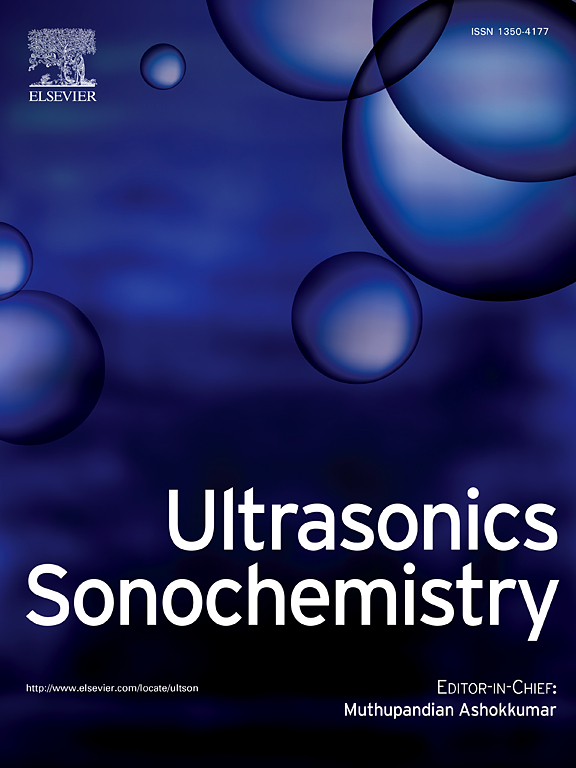Effect of driving frequency and power on droplet size atomized by a multimodal transducer
IF 8.7
1区 化学
Q1 ACOUSTICS
引用次数: 0
Abstract
Ultrasonic atomization is used in various applications such as medical devices, material synthesis, and humidity control. To meet the needs of different applications, the required droplet size ranges from a few microns to several hundred microns. In this study, we realized wideband multiple-frequency atomization with a multimodal transducer, which could control the size of atomized droplets by switching operating frequencies. A parabolic reflector served to focus the incident ultrasound waves, and a circular plate was employed to excite bending modes. By comparing the results of frequency response experiments with those of finite element simulation, nine different bending modes were acquired in the range of 500–2500 kHz. Then, 734, 949, 1530, and 2063 kHz were selected to examine atomization performance for producing 1–10 μm water droplets. The relationship between the droplet diameter and the operating frequency was clarified. The droplet diameter was found to follow a log-normal distribution. At these four frequencies, the mean droplet diameter was 7.71, 6.57, 4.87, and 4.43 μm, respectively, meaning that the diameter decreased with increasing frequency. The mean droplet diameter decreased with increasing input power at 734 kHz, whereas at 2063 kHz, no significant trend was shown. Furthermore, the atomization rate was found to increase at higher power and exhibited a frequency dependence. These results indicated that the multimodal transducer has promising potential for high-frequency ultrasonic atomization and the capacity to control the droplet size.
驱动频率和功率对多模态传感器雾化液滴大小的影响
超声波雾化技术应用广泛,如医疗器械、材料合成和湿度控制等。为满足不同应用的需要,所需的液滴尺寸从几微米到几百微米不等。在这项研究中,我们利用多模态换能器实现了宽带多频雾化,通过切换工作频率来控制雾化液滴的大小。抛物面反射器用于聚焦入射超声波,圆板用于激发弯曲模式。通过比较频率响应实验结果和有限元模拟结果,在 500-2500 kHz 范围内获得了九种不同的弯曲模式。然后,选择 734、949、1530 和 2063 kHz 来检测产生 1-10 μm 水滴的雾化性能。液滴直径与工作频率之间的关系得到了明确。研究发现,水滴直径呈对数正态分布。在这四种频率下,水滴的平均直径分别为 7.71、6.57、4.87 和 4.43 μm,这意味着水滴直径随着频率的增加而减小。在频率为 734 kHz 时,平均液滴直径随输入功率的增加而减小,而在频率为 2063 kHz 时,则没有明显的趋势。此外,还发现雾化率在较高功率下会增加,并表现出频率依赖性。这些结果表明,多模态换能器在高频超声雾化和控制液滴大小方面具有良好的潜力。
本文章由计算机程序翻译,如有差异,请以英文原文为准。
求助全文
约1分钟内获得全文
求助全文
来源期刊

Ultrasonics Sonochemistry
化学-化学综合
CiteScore
15.80
自引率
11.90%
发文量
361
审稿时长
59 days
期刊介绍:
Ultrasonics Sonochemistry stands as a premier international journal dedicated to the publication of high-quality research articles primarily focusing on chemical reactions and reactors induced by ultrasonic waves, known as sonochemistry. Beyond chemical reactions, the journal also welcomes contributions related to cavitation-induced events and processing, including sonoluminescence, and the transformation of materials on chemical, physical, and biological levels.
Since its inception in 1994, Ultrasonics Sonochemistry has consistently maintained a top ranking in the "Acoustics" category, reflecting its esteemed reputation in the field. The journal publishes exceptional papers covering various areas of ultrasonics and sonochemistry. Its contributions are highly regarded by both academia and industry stakeholders, demonstrating its relevance and impact in advancing research and innovation.
 求助内容:
求助内容: 应助结果提醒方式:
应助结果提醒方式:


